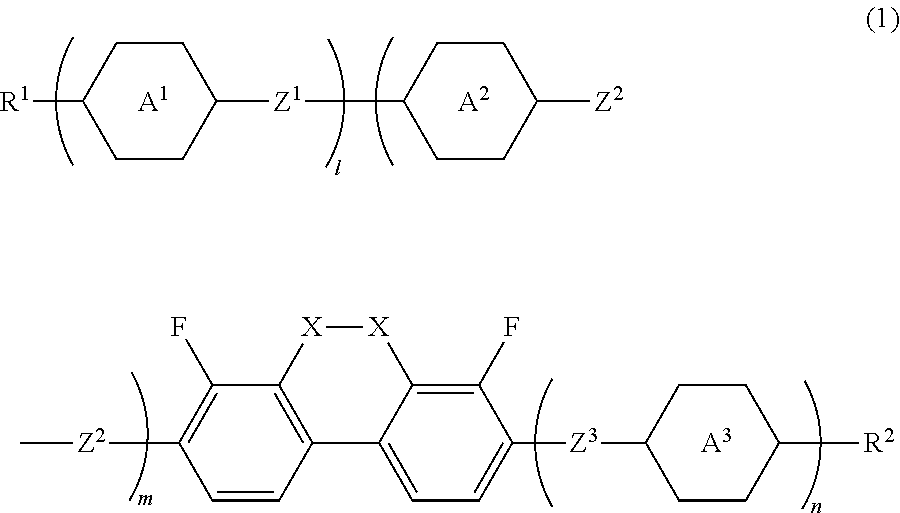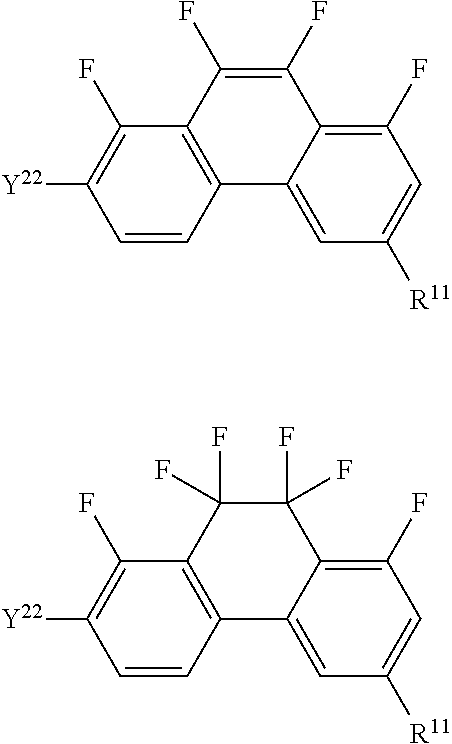Compound having dihydrophenanthrene, liquid crystal composition and liquid crystal display device
a technology of dihydrophenanthrene and compound, which is applied in the field of new liquid crystal compound and liquid crystal composition, can solve the problems of unsuitable liquid crystal compound, single liquid crystal compound satisfying, and undiscovered, and achieve excellent compatibility, high clearing point, and high heat resistance.
- Summary
- Abstract
- Description
- Claims
- Application Information
AI Technical Summary
Benefits of technology
Problems solved by technology
Method used
Image
Examples
examples
[0121]Hereinafter, the invention will be explained in more detail by way of Examples. The invention is not limited by the Examples. In each Example, C stands for a crystal, SA stands for a smectic A phase, SB stands for a nematic B phase, SX stands for a smectic phase of which structure is unanalyzed, N stands for a nematic phase, and I stands for an isotropic phase. All of units of a phase transition temperature are ° C. In addition, unless otherwise noted, “%” means “% by weight.”
[0122]A compound obtained was identified by a 1H NMR analysis, a mass spectrum analysis or the like. First, analytical methods will be explained.
1H NMR Analysis
[0123]As a measuring apparatus, DRX-500 (made by Bruker BioSpin Corporation) was used. A sample manufactured in Examples and so forth was dissolved into a deuterated solvent such as CDCl3 in which the sample was soluble, and measurement was carried out under the conditions of room temperature, 500 MHz and 24 times of accumulation. As a reference ma...
examples 1 and 2
Synthesis of 2-ethoxy-1,8-difluoro-7-propylphenanthrene-9,10-dione (58) and 2-ethoxy-1,8,9,9,10,10-hexafluoro-7-propyl-9,10-dihydrophenanthrene (No. 1)
[0153]
example 1
First Step
[0154]Under a nitrogen atmosphere, LDA (50.7 mL, 56.25 mmol) was slowly added dropwise, at −70° C. or lower, to a THF (100 mL) solution of 4-bromo-2-fluoro-1-propylbenzene (50) (11.1 g, 51.13 mmol). The reaction mixture was agitated at −70° C. or lower for 1 hour, and then DMF (6.15 g, 76.70 mmol) was slowly added dropwise thereto. The reaction mixture was returned to room temperature, and then quenched with 100 mL of 1N hydrochloric acid aqueous solution, and extracted with 60 mL of toluene 3 times. Combined organic layers were washed with a saturated aqueous solution of sodium hydrogencarbonate, water and saturated brine, dried over magnesium sulfate and a solvent was distilled off by evaporator. The residue was purified by silica gel column chromatography, and thus 6-bromo-2-fluoro-3-propylbenzaldehyde (51) (5.0 g, yield 36%) was obtained.
Second Step
[0155]In a manner similar to the operations for synthesizing compound (51), 6-bromo-3-ethoxy-2-fluorobenzaldehyde (53) (17...
PUM
| Property | Measurement | Unit |
|---|---|---|
| temperature | aaaaa | aaaaa |
| temperature | aaaaa | aaaaa |
| thickness | aaaaa | aaaaa |
Abstract
Description
Claims
Application Information
 Login to View More
Login to View More - R&D
- Intellectual Property
- Life Sciences
- Materials
- Tech Scout
- Unparalleled Data Quality
- Higher Quality Content
- 60% Fewer Hallucinations
Browse by: Latest US Patents, China's latest patents, Technical Efficacy Thesaurus, Application Domain, Technology Topic, Popular Technical Reports.
© 2025 PatSnap. All rights reserved.Legal|Privacy policy|Modern Slavery Act Transparency Statement|Sitemap|About US| Contact US: help@patsnap.com



